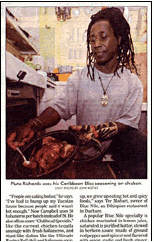Press: August 1, 2001
 Fighting Fire with Fire
Fighting Fire with Fire
When it’s hot outside, don’t grab the ice. Reach for the spice.
By Susan Houston
The News & Observer, Aug. 1, 2001
When North Carolina’s heat and humidity make you feel like a roasted chicken, what can you fix for dinner that will help you beat the heat? How about a spicy Indian curry? Or a steaming bowl of Chinese hot and sour soup? Or maybe a chicken you roast yourself, after rubbing it with Jamaican jerk seasonings?
If it sounds a little crazy to turn up the heat level in your food at the same time the outdoor temperature is rising, then you haven’t been paying attention to global cuisine. Some of the world’s spiciest foods come from the hottest places.
“Countries with hotter climates used spices more frequently than countries with colder climates,” says the 1998 report by professor Paul Sherman and then-student Jennifer Billing, published in Quarterly Review of Biology. “Indeed, in hot countries nearly every meat-based recipe calls for at least one spice and most include many spices, especially the potent spices.”
It’s not because spicy foods make people feel cooler, Sherman concluded. Instead, it was the microbe-fighting properties of spices that made them so popular in torrid climates where food spoiled so quickly in the days before refrigeration.
What happened over time, he said, was a kind of culinary Darwinism. Those who developed a taste for the spicy foods were the ones who lived to pass along their recipes to subsequent generations. Call it survival of the spiciest.
Pluto Richards of Carrboro, a Jamaica native, endorses Sherman’s theory. “I do know that jerk is a term that was used way before we had refrigeration,” he says. “When pirates used to travel the seas, they had to come up with a way to cure the food.”
About five years ago, he came up with his own blend of jerk spices to season meat. Pluto’s Caribbean Bliss is sold locally in gourmet and specialty stores and in Whole Foods and Garden of Eden stores in New York.
Traditional jerk seasoning already has a reputation for being spicy, but Richards found he had to up the cayenne ante to please his customers.
“There is a demand for hotter foods here,” he says. So in January, he introduced Fiery Blend, “which is kind of hot.”




